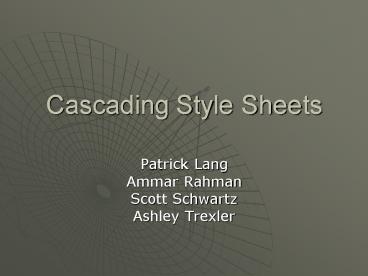Cascading Style Sheets - PowerPoint PPT Presentation
1 / 14
Title:
Cascading Style Sheets
Description:
Cascading Style Sheets. Patrick Lang. Ammar Rahman. Scott Schwartz. Ashley Trexler. What do they do? ... HTML was intended as just a structural markup language ... – PowerPoint PPT presentation
Number of Views:490
Avg rating:3.0/5.0
Title: Cascading Style Sheets
1
Cascading Style Sheets
- Patrick Lang
- Ammar Rahman
- Scott Schwartz
- Ashley Trexler
2
What do they do?
- Cascading Style Sheets (CSS) are a way to
separate the presentation from the structure of a
web site. - HTML was intended as just a structural markup
language and doesnt do a good job with the style
of the page.
- The purpose of a CSS is to provide Web developers
with a standard way to define, apply and manage
sets of style characteristics. - Font
- Color
- Size
- Background
- Margin indent
- Etc.
3
How do they work?
- All you do is write a style, the way you want
something on your page to look, in the style
section of the Head. Give it a name, then using
or surround the text in your body
that you want to be that style.
4
Cascading
- The "cascading" in Cascading Style Sheets refers
to how property values are applied in the context
of the parent/child hierarchy of the Web
document. - Child elements either inherit or override
property values bound to their parent elements
5
Style Sheet
- A style sheet is the encapsulation of style rules
in a centralized location, either in the head
section of the HTML document or in a separate
linked file. The Web browser reads these styles
and applies the specified formatting rules before
displaying the content.
6
Style Property
- If a value for a style property has not been
specified for a child element but has been
specified for its parent element, then the
parent's value is used to display the element - if the child element does specify a new value for
a style property also specified by the parent,
the browser uses the child's value to display the
element.
7
Example
- body
- font-family Verdana
- In the absence of any other instructions, the
browser will display all textual elements using
the Verdana font.
8
Separating Style from Content
- What does CSS offer over pure HTML that would
compensate for the additional complexity of using
both? - The primary benefit is the separation of style
and content - Does add some enhanced formatting and positioning
features
9
Separating Style from Content
- Empowers developers to create, use, and maintain
standardized presentation rules without touching
the content - Separating style from content also makes code
maintenance and reuse easier - Can easily apply standard, professionally
developed styles to newly published content - No need for markup or formatting languages
10
CSS Standards and Versions
- While the major browser vendorsMicrosoft and
Netscapeeach offer implementations of CSS in
their Web browser software, early implementations
of CSS by these browsers have been generally
incomplete, incompatible with one another, and
buggy. - W3C released the recommendation for CSS Level 1
- describes the foundation of the CSS language and
syntax, and includes basic formatting
functionality
11
CSS Standards and Versions
- The current W3C standard is the recommendation
for CSS Level 2 - CSS2 builds upon CSS1, adding support for style
sheets that target particular mediums (such as
printers), downloadable fonts, positioning, and
tables - CSS3 is currently under development by the W3C
and attempts to formalize these extensions in a
standard that captures common industry practice.
12
Future Trends
- Contribute 3
- Contribute 3 is a significant evolution of the
product, delivering substantial performance
improvements, support for current Web-design
techniques such as layouts based on Cascading
Style Sheets (CSS) - straightforward Web-page editor designed for
maintaining existing Web sites
13
Future Trends
- It enables users who don't necessarily build Web
sites-administrative assistants, instructors, or
marketing teams-to edit pages and add pages to an
existing Web site, without any assistance from
the Webmaster - Offers Better Performance
- Contribute 3 retrieves and publishes pages
significantly faster by caching many of the files
that Contribute 2 transferred via FTP - Cost is 50 more then Contribute 2
14
Questions?































